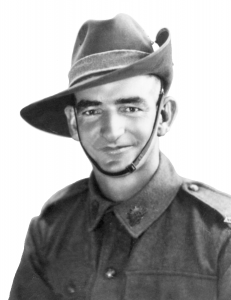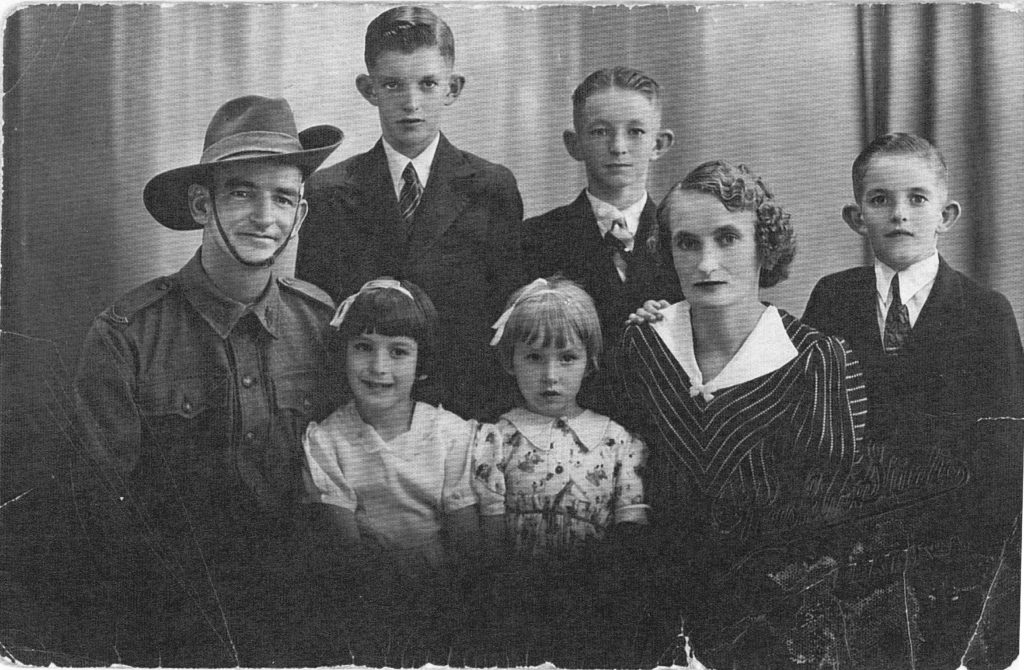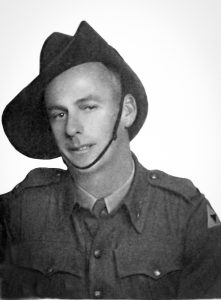The Danny Bevis Diary
Bevis worked on the Burma end of the Railway with ‘A’ Force Green Force No. 3 Battalion and in particular worked tirelessly as a medical orderly. Please read further.
WAR DIARY OF CORPORAL D.E. BEVIS WX9061
11TH Platoon ‘C’ Coy 2/4th Machine Gun Battalion 1939-1945
Following Capitulation 15 Feb1942 – marched from 3pm to 4am 17th Feb 42 to Changi.
Dep. Changi 15 May 1942 ‘Toyashi’ Maru with 2,000 POWs with only space for 500 for nine day journey via Medan, Sumatra to Victoria Point, Burma 24 May 1942 to work on the airfield (17 cases dysentery).
Dep. Victoria Point 6 Aug 1942 ‘Tatu’ Maru with 500 POWs (sufficiently large enough to carry 100 men) hugged coastline sailing north. Arrived Tavoy 9 Aug 1942. Barges to Tavoy. Aerodrome work. Food good.
Dep. Tavoy by truck 13 Aug 1942 for 62 miles remarkable trip over mountains – indescribable with monkeys galore.
Arrd. Ye Aug 13 1942. 300 Dutch had been ‘sword belted’ by Japanese Capt Ito. 40 Dutch were tied in line and belted. 12 Dutch POWs with dysentery were tied back to back in a circle. 2 Australian POWs belted unconscious.
Dep. Ye 25 Sep 1942 marching 28 miles without boots and no roads past blown bridges and through Burmese strikes. Slept Lamaigne. Jap guards threaten to bayonet POWs lagging behind. Board cattle train to Thanbyzuyat and Arr. 26 Sep 1942.
Endured Nagatomo’s speech. Air raid kills 39. 75 elephants on parade!
Start of railway line construction in Burma. They encounter Dr. Suzuti.
Dep. Thanby 1 Oct 1942 – Arr. Kendau 4 km Camp. Food is fair. Whitfield (not 2/4th) escapes, caught and shot by Japanese. Yak carts sick to Thanbyuzyat. Latex used for wounds. Major Green locked up for not signing no escape papers.
Dep. Kendau 1 Dec 1942 Arr. Thetkaw 14km.
Capt’s Mull, Dickenson and Bell escape. Caught near Rangoon. Two brought back and shot. First of searches – grenades in benjos.
Beltings on line by ‘Boy Bastard’ and ‘Boy Bastard’s Cobber’. Night raid on Thanbyuzyat.
Dep. Thetkaw 1 Mar 1943 Arrd. Meilo 75km Camp.
First malaria for Bevis. Blitzes of 300-400 men working 20 hours per day by bamboo flares. Heat and mosquitoes very severe. 12 in cemetery.
Dep. Meilo 75 km Camp 13 May 1943 marched 25 continuous miles to Aungganaung 105 Km Camp – men strewn over the road exhausted without clothes and boots. Shots fired.
Arrive Aunnganang 104 km Camp 14 May 1943.
Ulcers, dysentery, malaria, cholera & malnutrition. Searches, blitzes and bashings. ‘Snipe’ and ‘The Techa Donna’ responsible.
Reccy planes heard occasionally ‘a hunting we will go’ played by bugler!
Legs and arms amputated at 55 km. Murder of N.I. One man lost first night used flares to find ¾ mile to creek – very jittery. Rice and pig melon or radish water, sometimes-dry rice and salt.
Sick Dutch arrive in rotten condition – some dead on train.
Nip photo of funeral. Records buried in cemetery on leaving. Bob Ramage died 108 km. Cholera bodies burnt 118 km
Jungle leaves cooked and eaten – Dutch idea. Pitric Acid made from Lydite. ‘Bless them all’ sung and then marking time singing ‘Pack up your Troubles’.
(Picric acid has antiseptic and astringent properties. For medical use it is incorporated in a surface anaesthetic ointment or solution and in burn ointments.)
Dep. Aungganguang 1 Jan 1944. (All POWs being sent south to one of largerThailand Camps or hospitals.) One died on train to Tamarkan and buried alongside railway. Wampo Bridge is remarkable. Approximately 600 deaths.
Arrd. Tamarkan 2 Jan 1944.
From Tamarkan 1944 to Bangkok August 1945 (via Kachu Mountain, Petchaburi and Ratburi Camps during the last months of war)

Tamarkan, Thailand
‘Arrived Tamarkan 2 January 1944 from Burma. Food good to build up the Japan party, later torpedoed (Rakuyo Maru).
Camp is 60 yards away from ridge of eleven steel spans and a large AA position. Surrounded by observation post, nip engineers, cavalry camp and railway line. 21 planes over 29 November 1944. Four bombs dropped on camp. 18 killed and 38 wounded. Non Pladuk show 30 November 1944, 62 buildings, workshops, etc. wiped out. Bombs and bullets in camp 93 killed and 310 injured. Kanchanaburi bombed 13 December 1944. Several more raids as Tamarkan in December and quiet until 28 January 1945. Wooden bridge destroyed and repaired by us. One plane, on bomb, lost one whisky. 5 February, AA half a mile from camp, nip engineers and bridge bombed, 1,000 lb. First Red Cross parcels received 23 May 1944. 6 men to one parcel. First mail 28 May 1944.’
Chungkai, Thailand
‘Left Tamarkan 12 February 1945. March to Chungkai over bridge broke all records going over. Arrived Chungkai, 6 km, same day. Next day, 13 February bridge blown to pieces. Left Chungkai 19 February 1945.’
Non Pladuk
‘Arrived Non Pladuk 20 February 1945. Spent a night of expectancy as previous raid very noticeable. Nothing standing except portion of the POW Camp. In train 4 hours before leaving for Kachu Mountain 21 February. Detrained at blown bridge at Ratburi, Thai’s hostile to nips, pontoons over river.’
Kachu Mountain, Thailand
‘March to Kachu Mountain 86 km (53 miles). Self picked up in truck 15 miles out (malaria) and arrive Kachu Mountain 22 February. The rest arrive in a bad way on 24 February. Building two aerodromes No. 1 eight km from camp, No. 2 three km from camp. Conditions and nips no good. Self malaria all the time, nearly passed out. 26 planes ago over 28 April 1945, strafing drome. Machine gun mounted by nips outside hospital camp. Plenty blackwater fever. Storms every night. 7 huts blown down in typhoon. I eat python and armadillo, not too bad.’
Established in February 1945 and had it attained a strength of 2,526 by March which consisted of that and approximately equal numbers of British and Australian prisoners of war. The main work here was the construction of the landing strip and aerodrome. The camp site itself was originally a paddy field and after tackling many difficulties the camp was quite reasonable as a prisoner of war camp standards go. The work at this camp whilst hard was reasonable and the men’s health generally improved, as did relations with the Japanese. For about 10 days prior to 18 August 1945 everyone in camp suspected that something was afoot. Work on the aerodrome ceased on 15 August and on 18 August 1945 the Japanese Commandant announced that hostilities had ceased. Red Cross parcels and clothing that had been confiscated by the Japanese were made available immediately. This airstrip would at the end of the war, become a collecting and forwarding point for ex- prisoners of war. As men came into this camp from surrounding areas they would be processed and forwarded onwards by aircraft, initially to Rangoon and then directly to Singapore. In July 1945 1,000 prisoners were transferred from Kachu Mountain Camp to Petchaburi.
Petchaburi, Thailand
‘Left Kachu Mountain 1 July 1945. March to Petchaburi (18 miles). Self in truck after 10 miles, malaria again.’
This camp was located 100 miles to the south-west of Bangkok and according to Danny Bevis, about 12 miles from the Kachu Mountain Camp. The camp at Petchaburi consisted of 11 atap Buildings. Prisoners were engaged in digging of a canal from the railway line to allow the unloading of river barges directly onto the railway stock. They were also put to work digging air raid shelters and constructing weapons pits for Anti-Aircraft emplacements.
Major Charles Green, 2/4th MGB took over command of this camp on 6 September 1945 following his mission to accept Japanese surrender at Ubon a week earlier.
Ratburi
‘Train to Ratburi, damage of previous planes evidence. Stop for a night sitting up, Chinese say Wall one more month, he was right.’
There were two camps at Ratburi, one on an island in the middle of the river and the other on the Bangkok side of the river about 2 miles distant. At both camps the prisoners were operating a ferry service due to the fact that the bridges over the River had been destroyed by the Allied aircraft. The prisoners ran a relay service transferring goods from one train to another. A small group of prisoners from Tamuang had also arrived at Ratburi in February 1945 and were put to work on road and rail maintenance.
Nacompaton
‘Through Nacompaton, largest pagoda ever seen. There are hundreds of legless and armless men here, bridge blown to pieces.’
Nacompaton had been set up from December 1943 as a large hospital and convalescing camp. There were several members from the 2/4th who were involved with the construction of this camp including Eric Fraser and Frank ‘Blue’ Evans. This is where men like Tom Barbour, Syd Gorringe, Eric Ryan and Allan Bamford to name just a few who had limbs amputated and would remain at this camp until the end of the war. The camp its self was located about 30 miles to the west of Bangkok. As well as the amputees there were many prisoners of war who were sent to this camp to build up their strength following the construction of the rail link. As their health improved slightly they were again called upon to depart Nacompaton on work parties. On Japan’s surrender in August 1945 Nacompaton also became an Allied Forces Collection Centre for ex-prisoners of war. We were then either moved out via Bangkok to Singapore direct or via Rangoon to Singapore.
Bangkok
‘Arrive Bangkok 3 July 1945. Bombs have wreaked havoc at station and railway workshops. Took barge to go-downs. Big raids two weeks previous. Lofty Holdman killed, roofs wrecked. Do not like it here very much. Left go-downs 6 July 1945. Arrive Petchaburi 6 July. Left 0100 hours 7 July for Nakom Nayok.’
Nakom Nayok
‘March was murderous and at end of 45 km men were all ill. Nips would not pick up sick. Have been going with no food or boots for 33 hours continuous. Tried to refuse to March when three quarters of the distance was covered on account no water, but rifle and bayonet won the argument so we staggered on. Arrived Nakom Nayok on seven July 1945. Long hours and hard work digging dugouts, ammo dumps, etc, in the hills 8 km away. Plenty of lightning and storms, underwater constantly. Cannot dig latrines on account of water. Cement bags were split for cigarette papers. Left Nakom Nayok on 4 August 1945.’
Work for the prisoners at Nakom Nayok consisted mainly of digging. The digging of trenches or tunnels into the side of the hill to store supplies and petrol drums, thought to have been aviation fuel for the Imperial Japanese Army Air Service.
Lopburi
‘Arrive Lopburi 4 August 1945. 100 yards to 2 tarmacs, 3 transmitting stations and trucks, petrol dumps, hangers and nips galore. Surrounded by military objectives and confined to an area 75 yds square, under tents. 200 in a party and instructed that if any air activity not to move out of area or would be shot. One B-29 over and all keyed up for eventualities as one nip plane came from hanger to have a go at him. Nothing happened, nip plane crashed. Self route planned for escape if needed.’
Nakom Nayok
The Australians at Nakom Nayok had organized themselves into three groups which would all escape in different directions if it became necessary. (Apparently the same arrangements had been made at Lopburi). Lopburi was located about 100 miles to the north of Bangkok.
‘Told on evening of 16 August that we were to move back to Nakom Nayok next morning 17 August 1945. Thai’s shower truck with food etc. and we had an idea something had happened.’
‘On arrival at Nakom Nayok we were elated to see Yank, British and Dutch flags flying and we were notified that war had finished. Plane dropped men and supplies on 1st September, what a sight. One man through the roof of hut, also some parcels when chutes failed to open. Again on 3rd and4th September more supplies, clothes and medicines. One plane dare-devil flyer, very exciting. Lady Edwina Mountbatten visits camp.’
Bangkok
Situated at the Klong Toi Ports, there were 12 go-downs in four groups to the south east of the city. Not all the warehouses accommodated prisoners that by June 1945 were estimated, by Allied intelligence sources, to be in the region of 1000 men. At the end of the war the ex-prisoners of war were billeted at either the Sports Stadium Camp or the Tamasaart University camp.
‘Left Nakom Nayok 13 September 1945. Arrived in Bangkok at Tamasaart University 13 September. Wonderful buildings, Kings Palace, etc. in Bangkok. On 24 September left Bangkok 0850 hours Don Muang aerodrome and flew 900 -1,000 miles to Singapore, arriving after five hours 25 minutes flying time at 1415 hours. Bad weather on leaving, crossed the Gulf of Siam and South China Sea, thence east coast of Malaya. Views of paddy fields, rivers and jungles, magnificent. Had a couple of nasty bumps over South China Sea. All of the crew on board a Dakota plane. Height mostly 10,000 feet. Present quarters at Singapore just like civilization again and had my first drink of beer in 3 ¼ years. This was a record. Left Singapore ‘Tamaroa’ 29th of September 1945.
Home, West Aussie at last, 10 October 1945.’

Sadly Danny Bevis died four years later.
WX9059 George Robert (Bob) RAMAGE

Bob Ramage died of dysentery
23 Sep 1943 at Pyathonzu 108km
Camp aged 38 years.
